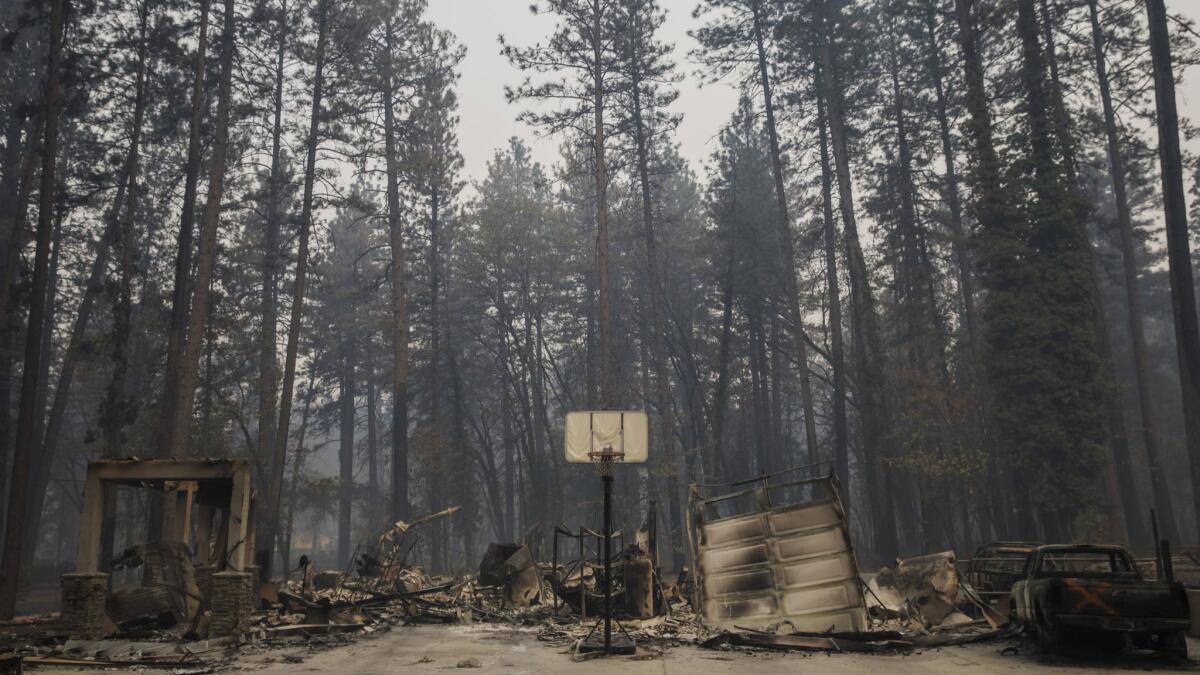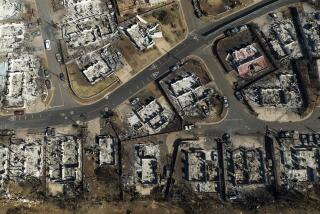PG&E highlights bullet-riddled equipment and downed tree branches near Camp fire in letter to state regulators

Just days after a lawsuit blamed a utility giantâs faulty equipment for Californiaâs deadliest wildfire on record, the company has submitted a letter to regulators saying it found bullet-riddled equipment and felled branches on power lines elsewhere within the fireâs massive footprint.
In a letter sent to the California Public Utilities Commission on Tuesday, Pacific Gas & Electric Co. said that a worker on Nov. 9 found bullet-riddled PG&E equipment and a felled power pole in Concow, and that days later another worker discovered branches on top of wires near Concow and Rim roads, an isolated crossroad leading up to Flea Mountain north of Concow where the Camp fire burned last month.
Four customers on the mountain near those two locations had experienced a power outage about 6:45 a.m. Nov. 8, the utility wrote, just as winds were driving the Camp fire into Concow, Magalia and eventually into Paradise, which was more than 90% destroyed by the blaze that killed at least 86 people.
A lawsuit filed on behalf of survivors Monday pointed to other PG&E equipment â a failed small metal hook that was supposed to hold up a transmission line and insulator on a tower in nearby Pulga â as the likely culprit for starting the fire. The utility acknowledged in Tuesdayâs letter that it did detect an issue with the equipment near Pulga about the time the Camp fire is believed to have started in that area.
But the potential of a second or even third ignition point for the fire â ones that werenât caused by a failure of PG&E equipment â could play a role in assigning liability down the road. If investigators find that fires started in either the location of the shot-up equipment or where branches fell onto power lines, and either of those fires overtook and consumed the blaze that started near Pulga, whoever is responsible could shoulder any civil and criminal liabilities for the devastation that followed.
Under Californiaâs liability laws for utilities, PG&E shareholders would have to absorb the costs if the utility was found to have caused the fire by neglecting to maintain its equipment. If its equipment was properly maintained but still caused the fire by, say, tree branches falling onto the lines and creating a shower of sparks that ignite grass below, PG&E customers could also be on the hook for some of the liability costs, not just the shareholders.
Utility officials declined to discuss the possibility that a private citizen shot their equipment and sparked the fire. They referred instead to their letter to the California Public Utilities Commission.
Meanwhile, the utility has proposed a rate increase to the commission that it said would help fund wildfire prevention efforts. More than half of the new revenue would fund a series of safety measures, including âstronger and more resilient polesâ and covered power lines across 2,000 miles of areas with high fire risk, and smart meters to more quickly detect fallen power lines, the utility said.
The proposed increase would raise a typical residential customerâs gas and electric bill by about $10.57 a month.
Attorney Steve Campora, who is representing more than 400 Camp fire survivors in litigation against PG&E, said he believes the utilityâs letter is an attempt to shift responsibility away from the company.
âI think thatâs why theyâre talking about it, but I donât think thatâs what happened,â he said.
So far, the California Department of Forestry and Fire Protection has not announced a cause for the Camp fire, though it has said there were two separate ignition points.
âOn Nov. 9, 2018, a PG&E employee on patrol arrived at the location of the pole ⌠and observed that the pole and other equipment was on the ground with bullets and bullet holes at the break point of the pole and on the equipment,â PG&Eâs letter stated. âOn Nov. 12, 2018, a PG&E employee was patrolling Concow Road north of [the bullet site] when he observed wires down and damaged and downed poles at the intersection of Concow Road and Rim Road. This location is within the Camp Fire footprint. At this location, the employee observed several snapped trees, with some on top of the downed wires.â
The lawsuit filed against PG&E this week argued that the utility giant has a history of putting profits before people and claimed that a cost-cutting culture resulted in an equipment failure that sparked the fire.
The suit alleges that PG&E has diverted ânecessary safety-related expenditures into funding corporate bonuses, boosting shareholder profits, and/or fueling advertising campaigns â while ignoring the serious and irreparable nature of the public safety threat posed by its aging infrastructure and ineffective vegetation management practices.â
An attorney in the litigation told The Times his firm plans to file 60 to 100 Camp fire lawsuits in the coming months, including several wrongful-death suits on behalf of families that lost loved ones.
The Camp fire started the morning of Nov. 8 and within hours overtook three mountain communities on its way to becoming the deadliest and most destructive fire in modern state history. Evacuations were hampered by limited escape routes and a wind-driven blaze that carried red-hot embers from home to home secluded within the tinder-dry forest, sparking one fire after another. Firefighters said it moved so fast that their only mission that morning was to help people escape because battling the fire was futile. It burned more than 153,000 acres before it was fully contained.
PG&E released a statement alongside its report about the second and third damaged equipment sites:
âThe loss of life, homes and businesses in the Camp Fire is truly devastating. Our focus continues to be on assessing our infrastructure to further enhance safety, restoring electric and gas service where possible, and helping customers begin to recover and rebuild. Throughout our service area, we are committed to doing everything we can to further reduce the risk of wildfire.â
Times staff writers Maria La Ganga, Diana Marcum and Alene Tchekmedyian contributed to this report.
Twitter: @JosephSerna
More to Read
Sign up for Essential California
The most important California stories and recommendations in your inbox every morning.
You may occasionally receive promotional content from the Los Angeles Times.











